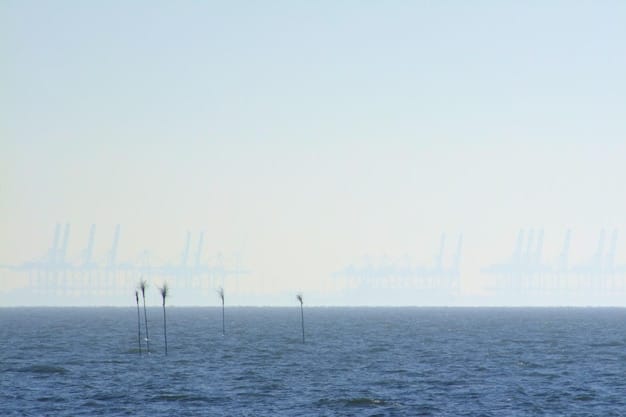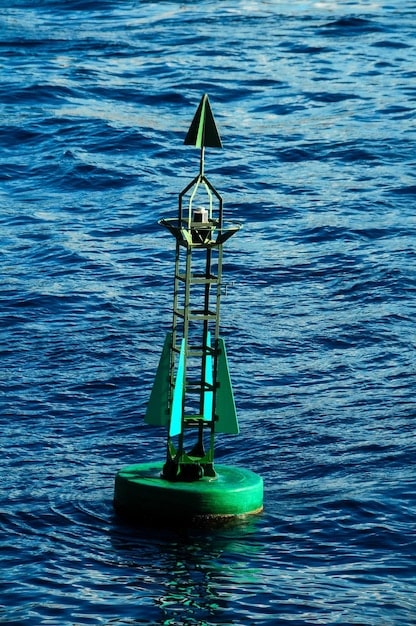Wave Energy Conversion: Latest Tech for US Coasts

Wave energy conversion (WEC) technology has seen remarkable advancements, with innovations such as oscillating water columns, point absorbers, and overtopping devices leading the charge in harnessing wave energy along US coastal regions.
As the world seeks sustainable energy solutions, the allure of harnessing the ocean’s power has never been stronger. In the United States, coastal regions are uniquely positioned to tap into the vast potential of wave energy. This article explores what are the latest advancements in wave energy conversion technology for US coastal regions? and how these breakthroughs can contribute to a cleaner, more resilient energy future.
Understanding wave energy conversion
Wave energy conversion is the process of capturing the kinetic and potential energy of ocean waves and converting it into electricity. This renewable energy source has the potential to provide clean, sustainable power to coastal communities. Numerous technologies are being developed and refined to efficiently harness wave energy.
The appeal of wave energy lies in its predictability and abundance. Unlike solar and wind energy, waves are more consistent and less intermittent, making them a reliable source of power. Let’s dive deeper into the technologies driving this field.
Types of Wave Energy Converters
Wave energy converters come in various forms, each designed to capture wave energy in different ways. The most common types include:
- Oscillating Water Columns (OWC): These devices use wave motion to compress air, which then drives a turbine to generate electricity.
- Point Absorbers: Floating structures that move with the waves, using this motion to drive hydraulic pumps or generators.
- Overtopping Devices: These devices capture waves in a reservoir, releasing the water to drive turbines as it flows back to the sea.
Each type has its advantages and disadvantages, making them suitable for different coastal environments and energy needs. The choice of technology often depends on factors such as wave climate, water depth, and grid connectivity.

Wave energy is a promising source of renewable energy with the potential to strengthen energy security and reduce carbon emissions, particularly in US coastal regions.
Latest advancements in oscillating water column (OWC) technology
Oscillating Water Column (OWC) technology is one of the most promising approaches to wave energy conversion. Recent advancements have focused on improving efficiency, reducing costs, and enhancing the durability of OWC devices.
These improvements are crucial for making OWC technology a viable energy source for US coastal regions. Let’s explore these advancements in more detail.
Optimized Turbine Designs
One of the key areas of innovation in OWC technology is turbine design. Researchers have developed advanced turbine designs that maximize energy capture from the oscillating airflow produced by the water column. These designs often involve:
- Variable-pitch blades: Adjusting the angle of the turbine blades to match the airflow, increasing efficiency.
- Wells turbines: Self-rectifying turbines that rotate in the same direction regardless of airflow direction.
- Impulse turbines: Designed to handle high-speed, intermittent airflow, improving energy conversion.
By optimizing turbine designs, OWC devices can generate more electricity from the same amount of wave energy, reducing the overall cost per kilowatt-hour.
Advanced Control Systems
Sophisticated control systems are also playing a vital role in improving OWC performance. These systems use real-time data on wave conditions to adjust the operation of the OWC device, optimizing energy capture and minimizing stress on the structure. Control strategies include:
- Wave prediction algorithms: Forecasting future wave conditions to proactively adjust turbine operation.
- Adaptive control: Continuously adjusting turbine speed and airflow resistance to maximize energy capture.
These control systems help OWC devices adapt to changing wave climates, improving their reliability and efficiency over the long term.
The evolution of OWC technology is crucial for coastal energy resilience and sustainable development, fostering economic growth and minimizing environmental impact.
Innovations in point absorber systems
Point absorber systems represent another significant category of wave energy converters. These devices capture energy from the heaving motion of waves, converting it into electricity. Recent innovations have focused on improving the efficiency, reliability, and scalability of point absorber systems.
These advancements are essential for making point absorbers a competitive energy solution for US coastal regions. Let’s delve into these innovations further.

Improved Hydraulic Systems
Hydraulic systems are a key component of many point absorber designs. Recent improvements have focused on enhancing the efficiency and durability of these systems, including:
- High-pressure hydraulics: Using higher pressures to reduce the size and weight of hydraulic components, improving efficiency.
- Sealed hydraulic systems: Preventing seawater from contaminating the hydraulic fluid, extending the life of the system.
- Advanced control valves: Precisely controlling the flow of hydraulic fluid to maximize energy capture.
By optimizing hydraulic systems, point absorbers can convert wave motion into electricity more efficiently and reliably.
Direct Drive Generators
Another area of innovation is the use of direct drive generators, which eliminate the need for gearboxes and other mechanical components. This reduces wear and tear, improving the reliability and lifespan of the system. Key features of direct drive generators include:
- Permanent magnet generators: Highly efficient generators that convert mechanical energy directly into electricity.
- Low-speed operation: Designed to operate at the same speed as the wave motion, eliminating the need for speed-increasing gearboxes.
Direct drive generators offer a simpler, more reliable way to convert wave energy into electricity, making point absorbers a more attractive option for coastal power generation.
The technological advancements in point absorber systems are key to unlocking the potential of wave energy, providing sustainable power solutions for coastal communities.
Advancements in overtopping devices
Overtopping devices capture wave energy by allowing waves to run up a ramp and fill a reservoir. The water then flows back to the sea, driving turbines to generate electricity. Recent advancements have focused on optimizing ramp designs, improving turbine efficiency, and enhancing the overall performance of overtopping devices.
These innovations are critical for making overtopping devices a viable energy solution for US coastal regions. Let’s explore these advancements in more detail.
Optimized Ramp Designs
The design of the ramp is crucial for maximizing the amount of water that is captured in the reservoir. Recent innovations have focused on:
- Curved ramps: Directing waves more effectively towards the reservoir, increasing water capture.
- Adjustable ramps: Adapting the ramp angle to match the wave conditions, improving energy capture.
By optimizing ramp designs, overtopping devices can capture more water from each wave, increasing the amount of electricity generated.
Low-Head Turbines
Overtopping devices typically operate with a relatively low head (the height difference between the reservoir and the sea). Recent advancements in turbine technology have focused on developing low-head turbines that are specifically designed for these conditions, including:
- Kaplan turbines: Highly efficient turbines designed for low-head applications.
- Rim generators: Integrating the generator directly into the turbine rim, eliminating the need for gearboxes.
These low-head turbines can generate electricity efficiently from the water flowing back to the sea, maximizing the energy output of overtopping devices.
The refinement of overtopping devices and similar wave energy technologies paves the way for a future powered by clean, renewable resources, contributing to the global push toward decarbonization and energy independence.
Challenges and opportunities for wave energy in the US
While wave energy holds immense promise, there are several challenges that need to be addressed before it can become a widespread energy source in the US. These challenges include high costs, environmental impacts, regulatory hurdles, and grid integration issues.
Overcoming these challenges will require a concerted effort from researchers, policymakers, and industry stakeholders.
High Costs
The cost of wave energy technology is currently higher than that of other renewable energy sources such as wind and solar. This is due to:
- Complex technology: Wave energy converters are complex devices that require advanced engineering and materials.
- Harsh marine environment: The ocean environment is harsh and corrosive, leading to high maintenance costs.
- Limited deployment: The lack of large-scale deployments means that there are few economies of scale.
Reducing the cost of wave energy will require further innovation, standardization, and increased deployment.
Environmental Impact
Wave energy converters can have potential environmental impacts, including:
- Habitat disruption: Devices can disrupt marine habitats and affect marine life.
- Noise pollution: Operating devices can generate noise that can disturb marine animals.
- Visual impact: Large-scale deployments can alter the visual appearance of the coastline.
Careful planning, siting, and monitoring are needed to minimize these impacts.
Despite the challenges, robust opportunities exist for wave energy in the US, particularly in states with extensive coastlines like California, Oregon, and Hawaii. These regions could significantly benefit from the development and deployment of wave energy technologies, fostering economic growth, creating jobs, and enhancing energy security.
Future outlook and research directions
The future of wave energy in the US looks promising, with ongoing research and development efforts focused on improving technology, reducing costs, and addressing environmental concerns. Several key research directions are likely to shape the future of wave energy.
These research directions will play a crucial role in making wave energy a viable and sustainable energy source for US coastal regions.
Materials Science
Advancements in materials science are crucial for developing wave energy converters that are durable, corrosion-resistant, and cost-effective. Key research areas include:
- Advanced composites: Developing lightweight, high-strength composite materials that can withstand the harsh marine environment.
- Self-healing materials: Creating materials that can repair themselves when damaged, reducing maintenance costs.
These materials will help to extend the lifespan of wave energy converters and reduce the need for costly repairs.
Grid Integration
Integrating wave energy into the existing electricity grid is another important area of research. This includes:
- Energy storage: Developing energy storage systems that can smooth out the intermittent output of wave energy converters.
- Smart grids: Using smart grid technologies to manage the flow of electricity from wave energy converters to consumers.
Effective grid integration will ensure that wave energy can be reliably delivered to consumers.
Further research and investment in wave energy technology are crucial for unlocking its full potential and creating a sustainable energy future for US coastal communities.
| Key Aspect | Brief Description |
|---|---|
| 🌊 Wave Energy | Harnessing wave motion to generate electricity. |
| ⚙️ OWC Tech | Using oscillating water columns for energy conversion. |
| ⚡ Point Absorbers | Floating devices capturing wave energy with hydraulic systems. |
| 📈 Overtopping Devices | Capturing waves in reservoirs and using low-head turbines. |
Frequently Asked Questions
▼
Wave energy conversion involves capturing the kinetic and potential energy from ocean waves and transforming it into usable electricity. This process is crucial for harnessing a consistent and abundant renewable energy source.
▼
Oscillating Water Columns (OWCs) are structures that use the motion of waves to compress air, which then drives a turbine to generate electricity. They are a promising technology for harnessing wave energy efficiently.
▼
Point absorber systems are floating structures that move with the waves. This motion drives hydraulic pumps or generators to produce electricity. They are designed to efficiently capture energy from the heaving motion of waves.
▼
Overtopping devices capture waves in a reservoir above sea level. The water then flows back to the sea, driving turbines to generate electricity. These devices are designed to maximize water capture and energy output.
▼
Key challenges include high costs, potential environmental impacts, regulatory hurdles, and grid integration issues. Addressing these challenges is crucial for the widespread adoption of wave energy in the US.
Conclusion
The latest advancements in wave energy conversion technology offer a promising pathway for US coastal regions to harness the ocean’s power. While challenges remain, ongoing innovations in oscillating water columns, point absorber systems, and overtopping devices are paving the way for a cleaner, more sustainable energy future. Continued research, development, and strategic deployment are essential to unlock the full potential of wave energy and contribute to a resilient and decarbonized energy landscape.





